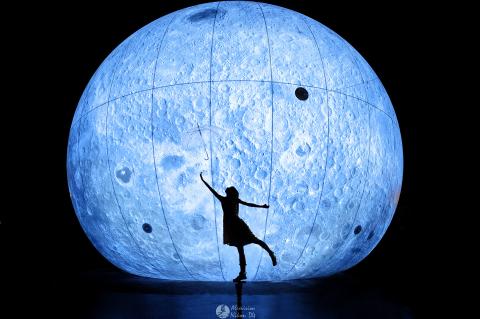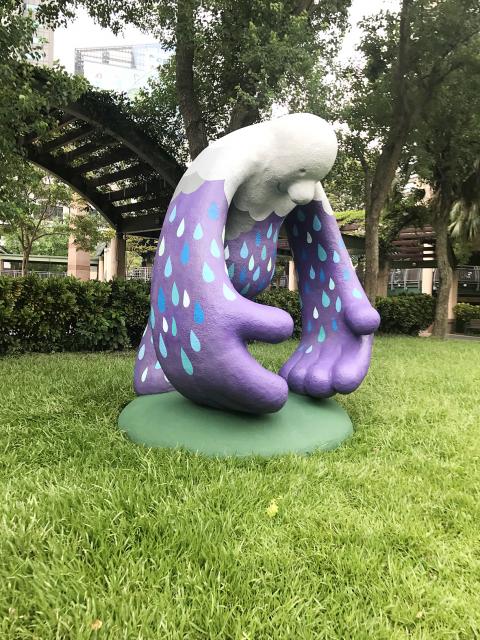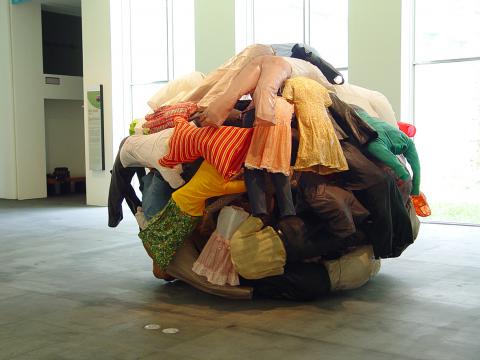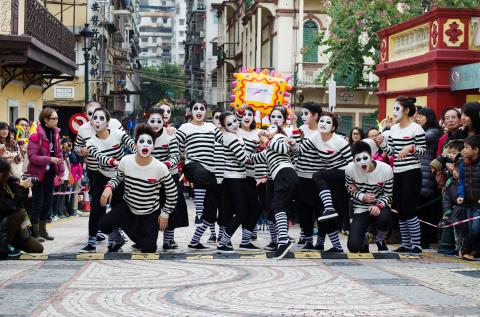The organizers of Nuit Blanche Taipei (臺北白晝之夜) have been on a steep learning curve, but it looks like the third installment of the world-wide night-long phenomenon will finally be hitting the right notes.
The idea behind Nuite Blanche, which was first held in Paris in October 2002, is for a city to become a huge art gallery for one night, opening up the art world and a city’s neighborhoods to a wider audience. Scores of cities now host their own Nuite Blanche on the first Saturday in October.
Taipei’s first effort in 2016 stretched from the North Gate (北門) to the 228 Peace Memorial Park (228和平公園), but coordination and promotional hiccups created more confusion than excitement. Last year’s event explored the west side of the city, centered around National Taiwan University, the Taipower Building and the Taipei City Hakka Cultural Park (客家文化主題公園).

Photo courtesy of Feng jiaCheng and Huang Yuanbei
This year’s event, which begins at 6pm on Saturday, runs along Zhongshan N Road from Section One, at the intersection with Nanjing W Road, to Section 3 and the Taipei Fine Arts Museum and Flora Expo Park, and unlike the first two, there will be performances at several sites up until 6am.
The theme for this year is “Upside Down City” with a goal of “liberating the space and redefining the city.
Organizers said Zhongshan N Road was chosen as the venue because its architecture and shops reflect different periods of Taipei’s history, from the Japanese colonial era to Taiwan’s economic boom and the cultural diversity represented today by the influx of migrant workers.

Photo courtesy of Tsai Chieh-hsin
The main sites include the Taipei Fine Arts Museum (TFAM), the Museum of Contemporary Art, Expo Hall, the Expo Dome, Taipei Artists Village, the Nanxi circle the Yushan MRT Station and around St Christopher’s Church.
Organizers have pulled together a program that features more than 70 performances or programs by Taiwanese and foreign artists, including migrant works, and several collaborative efforts, and 43 art installations.
The art installations have been placed around TFAM, Expo Hall and the small park at the intersection of Nanjing E Road and Linsen N Road.

Photo courtesy of Nuite Blanche Taipei
One of the more visible installations will be an environmental piece, Moon Haze, by Chinese artists Feng Jiacheng (馮嘉城) and Huang Yuanbei (黃苑倍), a 10m high inflatable moon that changes brightness according to the amount of fine particulate matter (PM2.5) in the air.
Major performances Herbert’s Dream by Compagnie des Quidams from France; One-Forty Migrant Stars, which brings together musicians and fashionistas among Taipei’s migrant worker population for a mix of concerts and runway shows; Noised (噪型) by the French-Taiwanese Sondes A/V Duo (電波接收器), an abstract audiovisual performance about city noises; and Night of Rebellion — Grand Dress-up Party, a drag queen showcase by performers from different generations.
The Midnight Service section will feature films at the Late Night Cinema and pop-up hotels at the two museums and Taipei Artist Village, although advance registration is required for these events.

Photo courtesy of L’Enfant Sauvage Physical Theatre
To make it easier to reach the different sites, the Mass Rapid Transit system is going to keep trains running between Taipei Main Station and Yuanshan Station until 6am.
There is a well-designed Web site (nuitblanchetaipei.info) with information in Chinese and English, including a program schedule, artist information and downloadable map.
The Taipei City Police Department announced yesterday that traffic controls would be imposed on Changan W Road starting at 3:30pm on Saturday and on Zhongshan N Road Sec 3 starting at 4pm.

May 18 to May 24 Pastor Yang Hsu’s (楊煦) congregation was shocked upon seeing the land he chose to build his orphanage. It was surrounded by mountains on three sides, and the only way to access it was to cross a river by foot. The soil was poor due to runoff, and large rocks strewn across the plot prevented much from growing. In addition, there was no running water or electricity. But it was all Yang could afford. He and his Indigenous Atayal wife Lin Feng-ying (林鳳英) had already been caring for 24 orphans in their home, and they were in

President William Lai (賴清德) yesterday delivered an address marking the first anniversary of his presidency. In the speech, Lai affirmed Taiwan’s global role in technology, trade and security. He announced economic and national security initiatives, and emphasized democratic values and cross-party cooperation. The following is the full text of his speech: Yesterday, outside of Beida Elementary School in New Taipei City’s Sanxia District (三峽), there was a major traffic accident that, sadly, claimed several lives and resulted in multiple injuries. The Executive Yuan immediately formed a task force, and last night I personally visited the victims in hospital. Central government agencies and the

Australia’s ABC last week published a piece on the recall campaign. The article emphasized the divisions in Taiwanese society and blamed the recall for worsening them. It quotes a supporter of the Taiwan People’s Party (TPP) as saying “I’m 43 years old, born and raised here, and I’ve never seen the country this divided in my entire life.” Apparently, as an adult, she slept through the post-election violence in 2000 and 2004 by the Chinese Nationalist Party (KMT), the veiled coup threats by the military when Chen Shui-bian (陳水扁) became president, the 2006 Red Shirt protests against him ginned up by

As with most of northern Thailand’s Chinese Nationalist Party (KMT) settlements, the village of Arunothai was only given a Thai name once the Thai government began in the 1970s to assert control over the border region and initiate a decades-long process of political integration. The village’s original name, bestowed by its Yunnanese founders when they first settled the valley in the late 1960s, was a Chinese name, Dagudi (大谷地), which literally translates as “a place for threshing rice.” At that time, these village founders did not know how permanent their settlement would be. Most of Arunothai’s first generation were soldiers